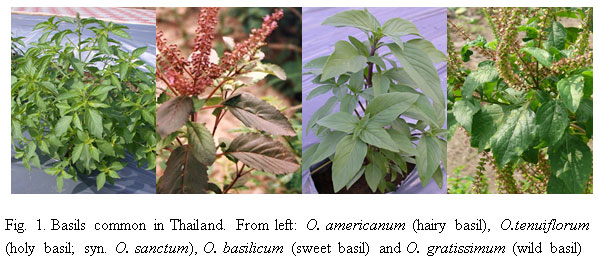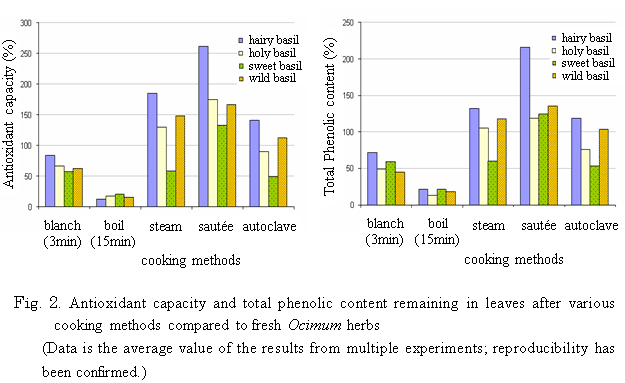Cooking method affects antioxidant capacity and total phenolic content in basils
Description
The effects of thermal treatment on the antioxidant properties of fruits and vegetables are important issues in home scale cooking as well as food manufacturing. In Southeast Asia, a variety of locally distinct conventional vegetables, including basil, are produced. Basil, a leafy herb, has recently been attracting research attention because it contains a variety of phenolic compounds which exhibit desirable physiological characteristics believed to provide health benefits. These native vegetables are mainly consumed as an ingredient in cooked dishes though they may also be eaten raw. This study, therefore, examined the changes in antioxidant capacity and total phenolics under five different heat cooking methods. We measured the antioxidant capacity (using the stable free radical diphenylpicrylhydrazyl / DPPH method) and total phenolic content (by Folin-Ciocalteu method) in methanol extracts of four Ocimum species commonly consumed in Thailand (Fig. 1) through blanching, boiling, steaming, sautéing, and autoclaving.
The results indicated that among the five cooking methods, sautéing was the best at increasing both antioxidant capacity and total phenolic content in all types of basil. Steaming also saw increases in all types except for sweet basil (Fig. 2).
Among the four species of basil, sautéed hairy basil showed the largest increases in both antioxidant capacity and total phenolic content, at more than double the amount of the untreated sample. On the other hand, both antioxidant capacity and total phenolic content in sweet basil were significantly reduced by cooking methods other than sautéing (Fig. 2). In particular, antioxidant capacity and total phenolic content of vegetables were reduced through blanching as existing components were released from plant tissues into cooking water. Additionally, the types of phenolics in basil extracts did not change greatly during sautéing, but the contents were observed to have increased. This is probably because the phenolics bound to methanol-insoluble materials tend to be isolated by heat cooking.
These results show that antioxidant capacity and total phenolic content in basils are affected by the method of cooking. It is also believed that heat cooking does not intend to promote phenolic contents, but changes it to a state that can be used. Consequently, it is possible to make processed rice that imparts antioxidant properties, for example, by boiling it in liquid in which antioxidants are eluted (JIRCAS Research Highlights, 2010).
Figure, table
-
Reference: Trakoontivakorn et al. (2012) JARQ 46: 347 353.
- Affiliation
-
Japan International Research Center for Agricultural Sciences Biological Resources and Post-harvest Division
- Classification
-
Administration B
- Research project
- Program name
- Term of research
-
FY 2010-FY 2012
- Responsible researcher
-
Trakoontivakorn Gassinee ( Kasetsart University )
Tangkanakul Plernchai ( Kasetsart University )
Nakahara Kazuhiko ( Biological Resources and Post-harvest Division )
- ほか
- Publication, etc.
-
Trakoontivakorn, et al.(2012), JARQ, 46(4): 347-353
- Japanese PDF
-
2012_19_A4_ja.pdf59.38 KB
- English PDF
-
2012_19_A4_en.pdf316.28 KB


